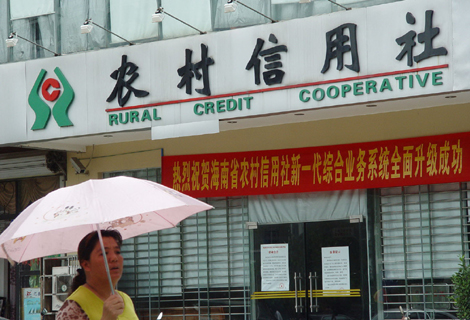Banking
Mergers in rural banks encouraged
By Li Xiang (China Daily)
Updated: 2010-09-02 09:44
 |
Large Medium Small |
|
 |
|
A woman walks past a rural credit cooperative in Haikou, Hainan province. [Shi Yan / for China Daily] |
BEIJING - The banking regulator said on Tuesday that it is pushing mergers and acquisitions (M&A) among the country's rural credit cooperatives (RCC) in a bid to reduce their high credit risks.
The M&A targets are RCCs that have a non-performing loan ratio higher than 30 percent. For a healthy RCC, the average non-performing loan ratio is 10 percent.
"The purpose is to dissolve the risks in China's rural credit market without closing these high-risk RCCs and reducing the supply of financial services in the rural areas," said Jiang Liming, deputy director of the Cooperative Finance Supervision Department of the China Banking Regulatory Commission (CBRC).
High-risk RCCs are rated five B, six A and six B on the banking regulator's ratings for accessing risk. There are 212 high-risk RCCs across the nation, accounting for 10 percent of the total RCCs, said the CBRC.
Commercial banks, cooperative financial institutions in rural areas, non-banking financial institutions and enterprises in solid financial standing could be potential buyers of RCCs that face dangerous exposure to non-performing loans.
Domestic banks are allowed to buy up to a 100 percent stake of an RCC while foreign financial intuitions and domestic enterprises can only purchase up to a 20 percent stake.
The RCCs acquired by larger financial institutions will also be transformed into stockholding entities, which will help strengthen their corporate governance and internal risk control, Jiang said.
The network of RCCs has been a key vehicle for the delivery of financial services to small-scale enterprises and individuals in rural China since their establishment during the rural cooperative movement in the 1950s.
Many RCCs suffer from high non-performing loan ratios, poor corporate governance, inadequate internal control and unclear ownership structure.
In 2003, the State Council issued a policy guideline to re-structure the RCCs in order to dissolve their historic financial burden and strengthen their corporate governance.
Over the years, the number of high-risk RCCs has been significantly reduced and the sector currently has an average capital adequacy ratio of 8 percent and a non-performing loan ratio of approximately 10 percent.



